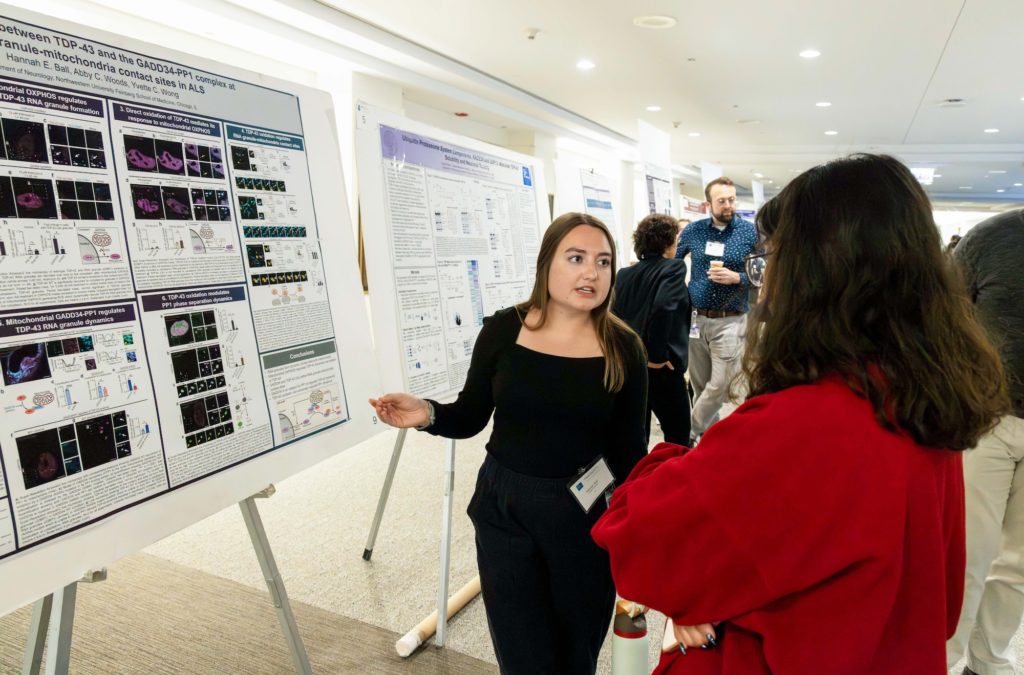Les Turner Symposium on ALS Celebrates Advancements

Northwestern scientists, clinicians and people living with ALS gathered to learn about the latest research and celebrate advancements in patient care during the 15th annual Les Turner Symposium on ALS held in at Northwestern Memorial Hospital on November 3.
The daylong event, which was held both in-person and virtually, featured presentations and a poster session highlighting new research on amyotrophic lateral sclerosis, or ALS, a progressive neurodegenerative disease that affects motor neurons in the spinal cord, causing muscle weakness and atrophy. An estimated 350,000 people worldwide currently live with ALS, which has an average survival rate of three years.
“Our goal is to start new collaborations and foster new ideas such that what we find and what we discover will be translated into effective treatment strategies. It is our obligation to connect the dots so that patients can actually live a better day,” said Hande Ozdinler, PhD, associate professor in the Ken and Ruth Davee Department of Neurology’s Division of Neuromuscular Disease and one of the symposium’s organizers, who welcomed attendees to this year’s symposium.
The symposium is sponsored in part by the Les Turner ALS Foundation and the Les Turner ALS Center at Northwestern Medicine. Established in 1979, the Les Turner ALS Center aims to accelerate cutting-edge research and provide life-enhancing treatment for people living with ALS.
“This symposium is a powerful example of the progress made possible through our longstanding partnership with Northwestern Medicine,” said Laura Freveletti, chief executive officer of the Les Turner ALS Foundation. “When pioneering research, compassionate care and the voices of the ALS community come together with shared purpose, we accelerate the path toward meaningful treatments and, ultimately, a cure.”

“We undertake the highest standards of clinical research and patient care, from observational studies to double-blind placebo-control phase three trials to wet bench science that is focused on finding answers. We are a leader, we are science and we are here,” said Robert Kalb, MD, the Joan and Paul Rubschlager Professor and director of the Les Turner ALS Center.
Yvette Wong, PhD, assistant professor of Neurology in the Division of Movement Disorders, presented her recent work investigating dynamic crosstalk between RNA granules — non-membrane structures that contain RNA and RNA-binding proteins — and mitochondria and how these mechanistic and functional interactions contribute to the development of ALS.
Using super-resolution live microscopy, Wong’s team discovered the formation of RNA granule-mitochondria contact sites — hubs for organelle bidirectional crosstalk — in oxidative phosphorylation conditions, further revealing novel key pathways that mediate crosstalk between mitochondria and RNA granules.
“Inter-organelle contact sites are key hubs for organelle bidirectional crosstalk, and critical for neuronal homeostasis and disrupted in neurodegeneration. However, how mitochondria and RNA granules interact at contact sites, and the role of reactive oxygen species generated from mitochondrial oxidative phosphorylation in mechanistically regulating this pathway was not known,” Wong said.
Han-Xiang Deng, MD, PhD, research professor of Neurology in the Division of Neuromuscular Disease, shared his research which found that the defective transport of large dense-core vesicles — lipid vesicles in neurons that contain neurotransmitters — underlies neurodegeneration in ALS type 5 (ALS5), the most common form of juvenile-onset ALS.

“These findings identify large dense-core vesicles as primary functional targets of spatacsin and establish defective large dense-core vesicle transport as a central pathogenic mechanism in ALS5 and related neurodegenerative disorders,” Deng said.
Christine Vande Velde, PhD, a full professor in the Department of Neurosciences at the Université de Montréal and the Université de Montréal Hospital Research Center, spoke about the role of stress granule dynamics as a potential central pathway in ALS pathogenesis. During her presentation, Vande Velde discussed her most recent work demonstrating that the TDP-43 protein stabilizes the mRNA encoding G3BP1 protein, a mechanism which is comprised in ALS patient neurons expressing TDP-43 pathology.
“A counterview to the role of stress granules in ALS/FTD is that they are neuroprotective and that the inability to launch a robust stress granule response lies at the heart of neuronal vulnerability in ALS/FTD,” Vande Velde said.
This year’s keynote address was delivered by Don Cleveland, PhD, distinguished professor in the Department of Cellular and Molecular Medicine at the University of California, San Diego.
Cleveland, an international leader in cancer biology, is credited with discovering the first microtubule associated protein, tau, which abnormally accumulates in Alzheimer’s disease and chronic brain injury, and for also discovering mechanisms of motor neuron degeneration in ALS.
Cleveland discussed his work in developing “designer DNA drugs” (antisense oligonucleotides), which silence increased expression of genes that cause or contribute to disease and are currently being tested in clinical trials for ALS, Huntington’s disease, Parkinson’s disease and Alzheimer’s disease.
“The development and use of this new class of drug has produced a watershed moment in ALS. For inherited forms, ALS progression can be slowed and partially reversed,” Cleveland said.
Cleveland also urged scientists to further pursue research in generating replacement neurons for the treatment of neurogenerative diseases.
“Designer DNA drugs can also be used to reactivate neurogenesis in dormant neurogenic niches of the aging in mammalian nervous system. The development of methods to generate replacement neurons has opened a new era for treating neurodegenerative diseases,” Cleveland said.
Following research poster presentations, the event concluded with a Q&A session featuring Cleveland and moderated by Senda Ajroud-Driss, MD, the Les Turner ALS Foundation / Herbert C. Wenske Professor and director of the Lois Insolia ALS Clinic at the Les Turner ALS Center at Northwestern Medicine.
Legal Disclaimer:
EIN Presswire provides this news content "as is" without warranty of any kind. We do not accept any responsibility or liability for the accuracy, content, images, videos, licenses, completeness, legality, or reliability of the information contained in this article. If you have any complaints or copyright issues related to this article, kindly contact the author above.
